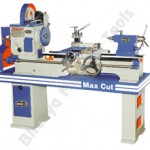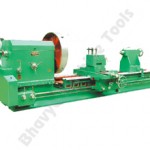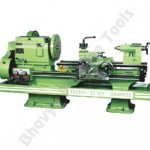 Giving shapes to rigid materials like wood and metals was not an easy job in ancient times. It was a back breaking job to remove unwanted parts from metals to give a specific shape. It is rightly said that necessity is the mother of invention. Due to this necessity of shaping, twisting and turning metals, lathe machine was invented. It is used to remove undesirable material to form specific shape in a metal. It was successful in reducing 50 per cent of human labour work due to which it became very much popular in workshops and since then there were many improvements brought in a lathe machine which added versatility to it. The applications are not limited to only one industry. There are various luxurious items made of metals which we use in our day to day life. It is used to shape, cut and twist those metals which make the process of manufacturing those products quite easy and quick. The size and functionality may vary from small lathe to huge lathe with lot many features. There are many types of lathe available like light duty lathe, medium duty heavy duty lathe machines, CNC lathe etc. The selection depends on the job to be accomplished in a workshop. For example a jeweler or a hobbyist may use a small lathe to complete their metal shaping jobs but if an industrial product is to be manufactured, then a huge and fully featured lathe machine is required. Before you buy It, you need to have complete information about different parts and how they work.
Giving shapes to rigid materials like wood and metals was not an easy job in ancient times. It was a back breaking job to remove unwanted parts from metals to give a specific shape. It is rightly said that necessity is the mother of invention. Due to this necessity of shaping, twisting and turning metals, lathe machine was invented. It is used to remove undesirable material to form specific shape in a metal. It was successful in reducing 50 per cent of human labour work due to which it became very much popular in workshops and since then there were many improvements brought in a lathe machine which added versatility to it. The applications are not limited to only one industry. There are various luxurious items made of metals which we use in our day to day life. It is used to shape, cut and twist those metals which make the process of manufacturing those products quite easy and quick. The size and functionality may vary from small lathe to huge lathe with lot many features. There are many types of lathe available like light duty lathe, medium duty heavy duty lathe machines, CNC lathe etc. The selection depends on the job to be accomplished in a workshop. For example a jeweler or a hobbyist may use a small lathe to complete their metal shaping jobs but if an industrial product is to be manufactured, then a huge and fully featured lathe machine is required. Before you buy It, you need to have complete information about different parts and how they work.
Lathe Machine and its Parts
 Basically, there are 6 main parts which are briefed below:-
Basically, there are 6 main parts which are briefed below:-
The Bed – It is a rigid and stable platform which is an aligning surface to place the material which is to be shaped. The headstock is on the left hand side and tailstock is on the right hand side of the lathe bed when the machine is viewed from the front side.
Headstock – The headstock turns the work piece by holding the spindle and drive mechanism. The spindle is rotated through a motor-driven belt or directly by a motor. The headstock can adjust speed adjustment with the help of gears or sliding pulleys which are mounted in its rear.
Tailstock – The tailstock allows accurate machining because it supports work which is time consuming, for example turning long pieces straight. A drill chuck is mounted in the tailstock for better results.
Carriage – The carriage moves left and right through manual operation of a hand wheel or driven by a lead screw. At the base of a carriage is a saddle that mates and aligns with the bed ways. It provides mounting and motion control components for cooling.
Cross Slide – The cross slide is placed on the top of the carriage to provide movement perpendicular to the length of the bed for cutting the work piece.
Lead Screw – As the headstock turns, the lead screw enables automatic feed and makes cutting possible.
 Thus, the above mentioned are the basic parts. The machine can be upgraded as per the job to be completed in a workshop. The smallest lathe machine can be found with a watch maker whereas, the largest lathe machine with many features can be found at industrial workshops. So, the selection depends on the job to be completed. Still, there are few things which should be considered before selecting for your workshop which are given below:-
Thus, the above mentioned are the basic parts. The machine can be upgraded as per the job to be completed in a workshop. The smallest lathe machine can be found with a watch maker whereas, the largest lathe machine with many features can be found at industrial workshops. So, the selection depends on the job to be completed. Still, there are few things which should be considered before selecting for your workshop which are given below:-
- Consider the spindle in the lathe you are buying. The spindle comes in standard and non-standard sizes, so you need to select which suits the requirement of your job as spindle is the core to the operations.
- The bed capacity is very much important as it will determine the size of the material on which you can work on.
- Different speed is selected for different jobs to be performed. If you are cutting a metal, you might need high speed but if you need to carve a metal which requires high accuracy, then you might prefer to work at a medium speed. So, make sure you can adjust to different speeds.
- Be careful with cheap lathe machine as it might be consisting of cheap parts which may wear out very soon.
If you are planning to buy and require having more information on it, visit http://www.bhavyamachinetools.com.





